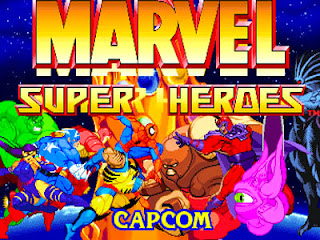First thing first, Marvel Super
Heroes has no balance whatsoever. I can’t even tell if it was intended to be a
competitive fighter because there is nothing here resembling fair. The game’s
main gimmick manages to kill any competitive scene the game could have
potentially had. The result is one of the fastest, most furious fighters to
come out of the Early 90s. As far as unbalanced fighters go, Marvel Super
Heroes is one of the better ones.
The
primary gimmick in Super Heroes is the Infinity Gems. These gems will
spontaneously appear during a match, after which you can pick up them up and
use them. Each of the six gems has a different ability ranging from boosting
your speed, to recovering your health to giving you infinite meter. They don’t
automatically activate either. Instead, you need to input a command to activate
them. When you do that, you’ve got a limited amount of time to take advantage
of your newfound power. A lot of the fights will probably boil down to knocking
gems off your opponent until you’ve gained the upper hand.
In
a more serious fighter, this mechanic wouldn’t work. But in a game like Marvel
Super Heroes, it works perfectly. It feels like a natural gimmick for a Marvel
fighter. Considering how many Marvel fighting games there are on the market,
this gimmick separates this title from its more serious brethren. Had it not
had the Infinity Gems, this game would have fallen by the wayside like Children
of the Atom before it.
The
game’s roster is comprised of ten characters, six heroes and 4 villains, plus
two unlockable characters (technically three). For a game in 1995, it’s an
average size roster although people more accustomed to the 40+ rosters of games
like Street Fighter IV and Marvel vs. Capcom 3 may be in for a bit of a
surprise. Darkstalkers fans will definitely dig the inclusion of Anita but
she’s little more than a test character. It’s a neat little bonus that was
formerly exclusive to Japan
and even though the novelty quickly wears off, it still deserves a mention.
Like
many other Capcom arcade games, Marvel is a visual feast. This game’s
spritework has aged fantastically. All the characters are bright and smooth
looking. They capture the look of a comic-book exceedingly well. There are some
coloring issues, like Shuma-Gorath, but the game looks superb nonetheless. The
backgrounds are solid too. In fact, I’d say that Super Heroes has some of the
best backgrounds in a Capcom fighter. The nighttime levels, like Psylocke’s and
Hulk’s, look really cool with dark colors and bright lights contrasting
brilliantly. Other levels, like Blackheart’s, are a bit more generic but the
good far outweigh the bad.
The
game’s soundtrack establishes some now-iconic songs but as a whole, it's lacking. Most of the songs in the game are pretty forgettable and
the sound leveling isn’t great either. The sound effects don’t completely
overshadow the music (and you can turn the volume of the sound effects down)
but they’ve got a lot more of a presence. Thankfully, the sound effects aren't grating and they actually sound really solid. They’ve got that old fighting
game sound to them where punches sound quick and brutal.
As
much fun as Super Heroes is, I’d have trouble recommending it anyone who
doesn’t have a few friends who are willing to spend an hour or two dicking
around with Captain America
and Wolverine. The entire Marvel vs. Capcom series outclasses this entry as
nearly the entire roster is available in at least one of those games. In truth,
this appears to have been added more as a bonus game. It’s a neat novelty but
it can be easily overlooked. A solid title for Marvel and fighting game fans
but most people will walk away underwhelmed.
Final Score: 5.5
Want to read more?




No comments:
Post a Comment